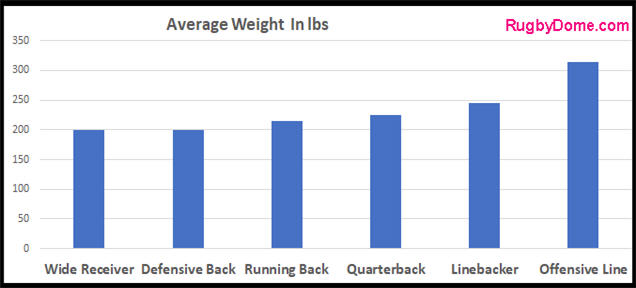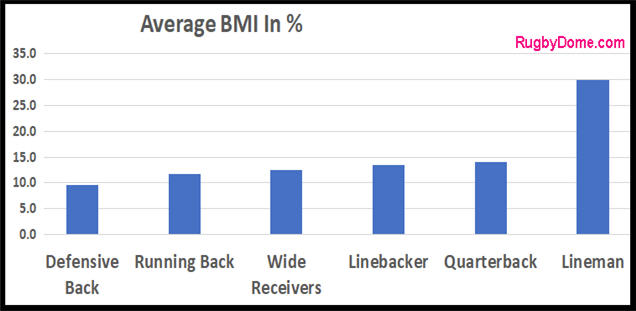The average weight of linemen in the NFL is 314 lbs in recent years. This is the heaviest position in football.
Linebackers, the next heaviest, are about 70 lbs lighter than linemen.
Aaron Gibson, an offensive tackle, has the highest recorded weight in the NFL at 410 lbs.
How Do Linemen Compare To Other NFL Positions?
Here is how NFL linemen weigh in against other positions. As you can see, they are top of the chart.

This table has the raw data:
| NFL | lbs |
| Offensive Line | 314 |
| Linebacker | 245 |
| Quarterback | 225 |
| Running Back | 214 |
| Wide Receiver | 200 |
| Defensive Back | 200 |
If you want more details, check out these in-depth articles:
- Average weights of linebackers in NFL and college football
- Average weights of running backs in NFL and college football
- Average weights of linemen in NFL and college football
- Average weights of quarterbacks in NFL and college football
- Average weights of wide receivers in NFL and college football
- Average weights of defensive backs in NFL and college football
How does this compare to college football?
College football players aren’t as heavy as professional NFL players, but they’re still very big.
The average weight of linemen in college football is 297 lbs, which is about seventeen pounds lighter when compared to the NFL.
Of course, this means that college recruits into the NFL have to spend their first season piling on the weight.
Back in 1999, a talented kid named Greg Ruegamer was a lineman at Arizona State. He weighed about 290 lbs in his senior year. The Miami Dolphins coach got on the phone to him on NFL draft day and asked him to add another 30 lbs.
How does this compare to the average American male?
The average American man weighs 196 lbs according to the CDC.
It’s not just that linemen are significantly heavier. Their average body fat percentage is nearly 30%, which is higher than the national male average.
This chart shows how far apart the average lineman is to the other NFL positions.

History Of Average Weights Of Linemen In The NFL
In the early 1900s, the average weight of professional linemen was 180 lbs.
This is why six brothers became box office when they joined the Columbus Panhandles in 1907. Like other big players, the Nesser brothers got their strength and muscle from working on the sandlots and railroad yards.
The brothers weighed more than 210 pounds, and crowds flocked to see them destroy opposing teams with their power.
Weights in the 1960s and 1970s
Let’s jump forward to the 1960s and ‘70s. The average weight for lineman was now hitting 250 pounds.
For example, Forrest Gregg and Jerry Kramer were both about 250 pounds when playing for the Green Bay Packers under Vince Lombardi.
Weights in the 1980s
During the 1980s, the average weight moved up to between 270 and 280 lbs.
Washington had one of the most feared offensive lines in the 80s. Known as the “Hogs”, they averaged just above 280 lbs.
Weights in the 2010s
By the time that the new century rolled in, linemen weights had started to balloon.
Alan Faneca weighed 315 lbs in 2014 when he played for the Arizona Cardinals.

How Do Linemen Maintain Their Weights?
It’s not easy to maintain a high weight with the kind of training that professional footballers go through.
Players follow up a morning workout with an intense session of weights. They can burn over one thousand calories each day during the season.
Obviously, they have to take in more food than they’re burning through exercise. So, how do they do it?
There’s a common tradition across the NFL franchises where the entire offensive line gets together for dinner in a restaurant.

First course
Typically, the meal starts with an order of three or four large portions of every appetizer on the menu.
That allows each player to mix and grab from a large selection of starters.
Second course
Things are a little more civilized with the main course. Each player will order their own meal. But they’ll order two or three different plates for themselves!
Who foots the bill?
The club doesn’t pick up the tab for these meals. Instead, the players pay the bill by rotation.
There’s a list, but rookies often find themselves at the top of it. The price tag can be a bit of a shock to newcomers.
How Do Linemen Compare To Other Sports?
Let’s take a look at heavyweights in boxing. Anthony Joshua weighs about 240 lbs, which is significantly lighter than the average 314 lbs of linemen.
The average weight of soccer players at the 2018 world cup was 170 lbs.
But it doesn’t make a whole lot of sense to compare NFL with soccer players. We should look at another contact sport.
Rugby is probably the closest sport, and the forwards in rugby can be big. But how do they compare to the NFL?
We’ve got an article on whether NFL players are bigger than rugby players. It compares both heights and weights between the sports.
Here is how linemen compare to locks:

As you can see, linemen average about 57 pounds more than their nearest equivalent position in rugby.
You can also check out our comparison of how much weights rugby players lift compared to the NFL.